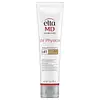Neutrogena Sheer Zinc Face Mineral Sunscreen SPF 50 Versus EltaMD, Inc UV Physical Broad-Spectrum SPF 41
What's inside
What's inside
 Key Ingredients
Key Ingredients

 Benefits
Benefits

 Concerns
Concerns

 Ingredients Side-by-side
Ingredients Side-by-side

Zinc Oxide 21.6%
Cosmetic ColorantWater
Skin ConditioningC12-15 Alkyl Benzoate
AntimicrobialOctyldodecyl Citrate Crosspolymer
HumectantStyrene/Acrylates Copolymer
Phenyl Trimethicone
Skin ConditioningCetyl PEG/PPG-10/1 Dimethicone
EmulsifyingDimethicone
EmollientPolyhydroxystearic Acid
EmulsifyingGlycerin
HumectantEthyl Methicone
EmollientCetyl Dimethicone
EmollientSilica
AbrasiveColloidal Oatmeal
AbsorbentTocopheryl Acetate
AntioxidantChrysanthemum Parthenium Flower/Leaf/Stem Juice
AntioxidantGlyceryl Behenate
EmollientPhenethyl Alcohol
MaskingCaprylyl Glycol
EmollientCetyl Dimethicone/Bis-Vinyldimethicone Crosspolymer
EmollientAcrylates/Dimethicone Copolymer
Skin ConditioningSodium Chloride
MaskingPhenoxyethanol
PreservativeChlorphenesin
AntimicrobialZinc Oxide 21.6%, Water, C12-15 Alkyl Benzoate, Octyldodecyl Citrate Crosspolymer, Styrene/Acrylates Copolymer, Phenyl Trimethicone, Cetyl PEG/PPG-10/1 Dimethicone, Dimethicone, Polyhydroxystearic Acid, Glycerin, Ethyl Methicone, Cetyl Dimethicone, Silica, Colloidal Oatmeal, Tocopheryl Acetate, Chrysanthemum Parthenium Flower/Leaf/Stem Juice, Glyceryl Behenate, Phenethyl Alcohol, Caprylyl Glycol, Cetyl Dimethicone/Bis-Vinyldimethicone Crosspolymer, Acrylates/Dimethicone Copolymer, Sodium Chloride, Phenoxyethanol, Chlorphenesin
Zinc Oxide 9%
Cosmetic ColorantTitanium Dioxide 7%
Cosmetic ColorantWater
Skin ConditioningIsopropyl Palmitate
EmollientEthylhexyl Stearate
EmollientOctyldodecyl Neopentanoate
EmollientAlumina
AbrasivePolyacrylate-13
Phenoxyethanol
PreservativeHydrogen Dimethicone
Polyisobutene
Hydrogenated Polyisobutene
EmollientTriethoxycaprylylsilane
Oleth-3 Phosphate
Tocopheryl Acetate
AntioxidantBisabolol
MaskingTocopherol
AntioxidantCarnosine
Skin ConditioningEthylhexylglycerin
Skin ConditioningSorbitan Isostearate
EmulsifyingPolysorbate 20
EmulsifyingZingiber Officinale Root Extract
MaskingIron Oxides
Zinc Oxide 9%, Titanium Dioxide 7%, Water, Isopropyl Palmitate, Ethylhexyl Stearate, Octyldodecyl Neopentanoate, Alumina, Polyacrylate-13, Phenoxyethanol, Hydrogen Dimethicone, Polyisobutene, Hydrogenated Polyisobutene, Triethoxycaprylylsilane, Oleth-3 Phosphate, Tocopheryl Acetate, Bisabolol, Tocopherol, Carnosine, Ethylhexylglycerin, Sorbitan Isostearate, Polysorbate 20, Zingiber Officinale Root Extract, Iron Oxides
Ingredients Explained
These ingredients are found in both products.
Ingredients higher up in an ingredient list are typically present in a larger amount.
Phenoxyethanol is a preservative that has germicide, antimicrobial, and aromatic properties. Studies show that phenoxyethanol can prevent microbial growth. By itself, it has a scent that is similar to that of a rose.
It's often used in formulations along with Caprylyl Glycol to preserve the shelf life of products.
Tocopheryl Acetate is AKA Vitamin E. It is an antioxidant and protects your skin from free radicals. Free radicals damage the skin by breaking down collagen.
One study found using Tocopheryl Acetate with Vitamin C decreased the number of sunburned cells.
Tocopheryl Acetate is commonly found in both skincare and dietary supplements.
Learn more about Tocopheryl AcetateWater. It's the most common cosmetic ingredient of all. You'll usually see it at the top of ingredient lists, meaning that it makes up the largest part of the product.
So why is it so popular? Water most often acts as a solvent - this means that it helps dissolve other ingredients into the formulation.
You'll also recognize water as that liquid we all need to stay alive. If you see this, drink a glass of water. Stay hydrated!
Learn more about WaterZinc Oxide is a mineral broad-spectrum UV filter; it is the broadest UVA and UVB reflector approved by the FDA. It also has skin protectant and skin soothing properties.
Zinc oxide is one of the most effective broad-spectrum UV filters. It protects against UVB, UVAII, and UVAI. In comparison to its counterpart titanium dioxide, zinc oxide provides uniform and extended UVA protection.
Another great benefit? This ingredient is highly photostable so it won't degrade easily under sunlight.
A common myth is that mineral UV filters are widely believed to primarily reflect UV light.
However, modern research shows titanium dioxide absorbs UV radiation like chemical filters (~95% absorption & 5% reflection).
Zinc oxide has great skin soothing properties so you'll likely find this in sunscreens formulated for sensitive skin or babies/children. It is unlikely to cause "eye sting" like other sunscreen ingredients.
Regulatory agencies consider zinc oxide to be non-toxic and safe. It has also been shown to not penetrate the skin.
Unfortunately, this ingredient does leave a visible white cast. This is why mineral sunscreens are often less cosmetically elegant than chemical or hybrid ones.
In cosmetics, zinc oxide can be found in both non-nano and nano-sized forms. The nano version is used to reduce white cast and improve the texture of sunscreen formulas.
There are ongoing concerns surrounding nano-zinc oxide's impact on marine ecosystems and whether it can be absorbed into skin.
Regarding marine ecosystems and coral reefs, there is no conclusive evidence that any form of zinc oxide (or any other sunscreen ingredients) will cause harm. The science is still developing but many consumers are keeping a close eye on this issue.
Please note, many destinations have reef-safety sunscreen rules. For instance, the U.S. Virgin Islands advises all visitors to use non-nano mineral sunscreens.
There has also been some stir about whether micronized or nano zinc oxide has potential photoxicity and absorption through the skin/lungs.
An in-vitro (done in a test tube or petri dish) study demonstrated micronized zinc oxide to have potential phototoxicity. There's no need to fret; the EU Commission's Scientific Committee on Consumer Safety has stated, "The relevance of these findings needs to be clarified by appropriate investigations in vivo." Or in other words, further studies done on living organisms are needed to prove this.
Current research shows zinc oxide nanoparticles do not penetrate intact or sunburned skin. They either remain on the surface or in the outermost layer of dead skin (stratum corneum).
Zinc oxide is one of only two classified mineral UV filters with titanium dioxide being the other one.
Fun fact: Zinc has been used throughout history as an ingredient in paint and medicine. An Indian text from 500BC is believed to list zinc oxide as a salve for open wound. The Ancient Greek physician Dioscorides has also mentioned the use of zinc as an ointment in 1AD.
Learn more about Zinc Oxide